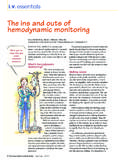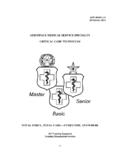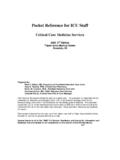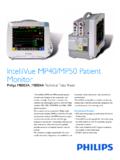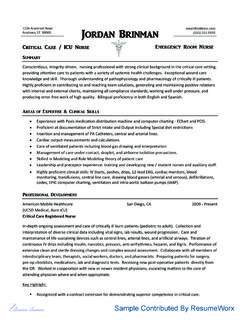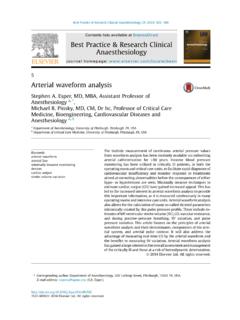Transcription of Topic Review MRI Perfusion Imaging in Acute …
1 1 Adamczyk Topic Review MRI Perfusion Imaging in Acute ischemic Stroke Peter Adamczyk, MD and David S Liebeskind MD Department of Neurology, University of California, Los Angeles, CA Introduction Stroke remains a prevalent disease with an estimated 795,000 new or recurrent annual events in the and continues to be a leading cause of adult disability exacting an enormous financial toll on the health care system. [1] Ischemia accounts for the vast majority of stroke causes and occurs when vessel occlusion disrupts oxygenated blood Perfusion to an area of the brain resulting in injury. The ability to image cerebral blood flow initially exploited angiographic techniques first created in the 1920 s and subsequent radionuclide methods developed in the 1960 s permitted in vivo brain Perfusion measurements.
2 [2] Investigation of magnetic resonance Imaging (MRI) to assess Perfusion began during the 1990 s but has only recently evolved for clinical use over the past decade largely as a result of advancements in rapid image acquisition methods. [3] MRI Perfusion Imaging (PWI) represents a form of functional Imaging that assesses alterations in blood flow with additional information on metabolism and regional measures of a specific tracer. This technique has been employed for a variety of conditions, but it is most commonly used in cerebrovascular disorders, especially Acute ischemia. The role of such Imaging began to play a prominent role after publication of the National Institute of Neurological Disorders and Stroke (NINDS) recombinant Tissue Plasminogen Activator Stroke Study and the European Cooperative Acute Stroke Study (ECASS) results in 1995, when emphasis became geared towards timely identification and rescue of viable hypoperfused tissue with thrombolytics.
3 [4-5] While additional revascularization strategies have since been developed, the central premise behind treatment remains the same and aims to restore potentially salvageable ischemic brain tissue in order to prevent irreversible infarction. This territory of restorable tissue represents the ischemic penumbra and patients identified with a larger penumbra are more likely to benefit from recanalization therapies making it crucial to properly recognize them. [6-7] Multimodal MRI including Perfusion sequences has been hypothesized to provide a visual representation of the ischemic penumbra prompting recent strong interest in this technique for implementation in Acute stroke management.
4 This paper will explore the basic concepts of MRI Perfusion and its clinical utility in Acute ischemic stroke as well as its current limitations. Cerebral Perfusion in Ischemia 2 Adamczyk Measurement of Perfusion is based on analysis of a hemodynamic time-to-signal intensity curve generated when a tracer passes through the cerebral circulation. (See Figure 1) This curve may be processed by different means to extract parameters that reflect either the cerebral blood flow (CBF), cerebral blood volume (CBV) or mean transit time (MTT) which are linked by the equation CBV = CBF MTT, also known as the central volume principle.
5 In normal brain tissue, vessel autoregulation maintains CBF at 50-60 mL/100g/min., but during early ischemia, the CBF diminishes while CBV rises slightly or is maintained at near normal level due to dilatation of the vascular bed. When CBV begins to decrease or when CBF falls to < 20% of normal (10-12 mL/100gm/min), irreversible cell death has occurred. [8] Figure 1: Time- Tracer Concentration Curve demonstrating the relationship of different Perfusion parameters in normal tissue and during infarction. CBF = Cerebral Blood Flow. CBV = Cerebral Blood Volume. MTT = Mean Transit Time. TTP = Time To Peak.
6 This transition from ischemia to infarction not only depends on CBF values but also on the duration of the diminution in blood flow. [9] Transit times become delayed early in the course of the ischemia typically due to occlusive lesions and subsequently rise to immeasurable levels as infarction ensues and downstream resistance increases. Two parameters of transit time include MTT as well as time to peak (TTP), which reflects time from the beginning of the contrast injection to the peak enhancement within a region of interest. In general, tissue at risk of infarction will have normal or decreased CBF, normal or elevated CBV, and elevated MTT/TTP, while infarcted tissue will have decreased CBF and CBV with elevated MTT/TTP.
7 [10-11] (See Table 1) 3 Adamczyk Table 1: A simple representation of typical changes that occur with each Perfusion parameter in normal brain tissue as it progresses towards infarction. MRI Perfusion Techniques Different MRI techniques are available for cerebral Perfusion measurements in routine clinical practice, but a contrast-enhanced dynamic susceptibility T2* weighted technique remains the most common method. For this method, approximately 20 mL of gadolinium is injected at 4-6 mL/sec. and an echoplanar sequence is used to acquire whole brain coverage with 12 slices during a 90-120 second acquisition time.
8 [12-13] The flow of paramagnetic contrast agent through the cerebral circulation produces a nonlinear signal loss due to the contrast susceptibility or T2* effect. [14] Tissue signal changes produced by this T2* effect are implemented to create the time-to-signal intensity curve. These signal intensity changes may then be used to create color-coded or intensity-coded hemodynamic maps from either raw data or processed data from deconvolution algorithms based on the arterial input function (AIF) which is often estimated from the middle cerebral artery and reflects the arterial concentration of contrast agent distributed in time.
9 Various hemodynamic parameters such as relative CBF in mL/min, relative CBV in mL, MTT in sec., and TTP in sec. as well as Time to bolus arrival may be obtained (See Figure 1) and the contralateral brain tissue often serves as a normal control for which relative Perfusion values may be compared. The arterial spin labeling (ASL) technique is an additional technique that does not require the use of a contrast agent but rather utilizes the spins of endogenous water protons as a tracer. In the Pulsed Arterial Spin Labeling (PASL) method, the application of a short radiofrequency pulse tags arterial blood flowing upstream by inverting the spin polarity of protons flowing into the Imaging plane.
10 Another technique known as the Continuous Arterial Spin Labeling (CASL) method utilizes a continuous radiofrequency of weak intensity to label blood upstream of the slice. With either 4 Adamczyk method, subtraction of control from spin labeled images allows measurement of Perfusion parameters. Although these methods remain promising for patients with gadolinium contraindications, ASL currently remains investigational as it is difficult to implement, especially on intermediate or low field strength below and the signal to noise ratio is relatively low allowing for significant contamination from blood-oxygenation-level-dependent effects.



